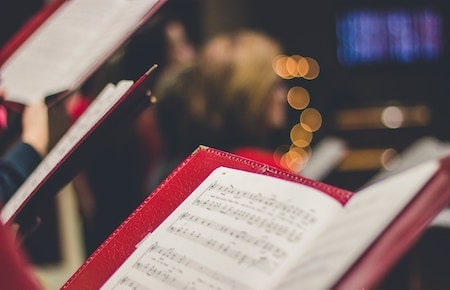
Aria from the Messiah by Handel. This arrangement follows Handel's original score and the performance tempos as performed originally by the London Symphony Orchestra. Scored for orchestra and tenor voice. Perfect solo piece for the holidays.
E

Chorus piece from Handel's "Messiah" following the original score, and recorded to sound similar to the London Symphony Orchestra's performance. Perfect for SATB choir.
A

Following Handel's original score, this is a complete orchestral recording of the Fifth movement from Messiah, Thus Saith the Lord -- an accompanied recitative for solo Bass vocal.
Dm

The sixth movement from Handel's Messiah - an aria for solo Alto. This orchestral recording follows Handel's original score, featuring strings, winds, and harpsichord. Popular oratorio for Christmas and Easter.
Dm

The seventh movement from Handel's Messiah, a full SATB chorus. This orchestral recording follows Handel's original score, featuring strings, winds, harpsichord, and organ. Popular oratorio for Christmas and Easter.
Gm

The eighth movement of Handel's Messiah, a very brief rubato recitative for alto soloist. Only six measures long, it begins in the key of D, but ends in A.
D

The ninth movement in Handel's Messiah begins with an alto aria, and ends with a triumphant SATB chorus. Together, they create a massive and grand piece of music. Smooth and flowing, this interpretation is inspired by the well-known London Symphony Orchestra recordings.
D

This long, slow, beautiful soprano aria begins the Third Part of Handel's Messiah. Very smooth and legato, this is a common solo for Easter. Tempos and direction are inspired by the well-known London Symphony Orchestra recordings. This is movement 45 of the Messiah.
E

In this menacing bass aria, Handel signals darkness and danger with a "Jaws"-like musical motif in the orchestra. Simple and captivating, this is movement ten of the Messiah. Perfect for Easter or Good Friday. Direction is inspired by the London Symphony Orchestra recordings.
Bm

Movement thirteen in Handel's Messiah is the only purely instrumental movement, without any singing at all. It's useful as an interlude, contemplative moment, or during an intermission. The title "Pifa" suggests shepherds' music played traditionally at Christmas by the Italian "pifferare" (pipers or shepherds).
C

A powerful, strong SATB choral work, movement 24 of Handel's Messiah. In only 19 measures, the choir sings powerful unison rhythms, soft contrapuntal entrances, and a forceful antiphonal ending. Beautiful and recognizable.
Fm

A slow, moving aria for alto, Movement 23 of Handel's Messiah, describing Christ's sorrows. Strings gently weep in the accompaniment. As the A section is over five minutes in length, Handel's instructions to continue with a bridge and then repeat the A section in its entirety are rarely followed. This recording ends, like most, at the end of the A section; the bridge is available separately as Spiritrax 1209, "He Gave His Back to the Smiters".
Eb

This slow minor-key SATB chorus is Movement 22 of Handel's Messiah, opening the second part. Beautiful and dramatic canonic entrances, with all the choral parts clearly mirrored in the orchestra.
Gm

This grand and peaceful SATB chorus is movement 21 of Handel's Messiah. The last movement in Part 1, it is usually the last song before intermission in performances of the full work. Gentle and easy to sing with a triumphant ending, with a text simple enough for anyone to understand.
Bb

Movement 20 in Handel's Messiah is a gentle, flowing double aria for alto and soprano. The text describes how Jesus will protect his people. The alto sings the first half in F, and then the soprano takes over in Bb for the second half. Simple and beautiful. Could be done by one singer with a large range, but really perfect to feature two.
F